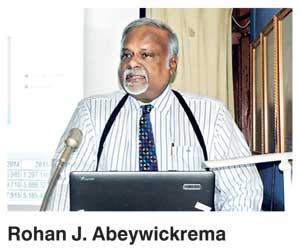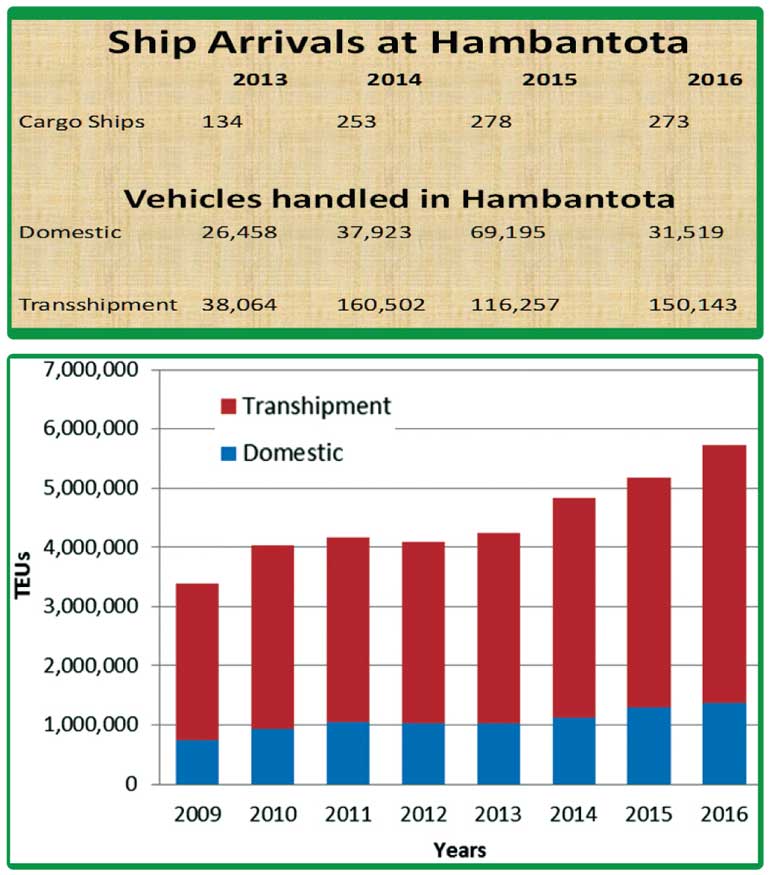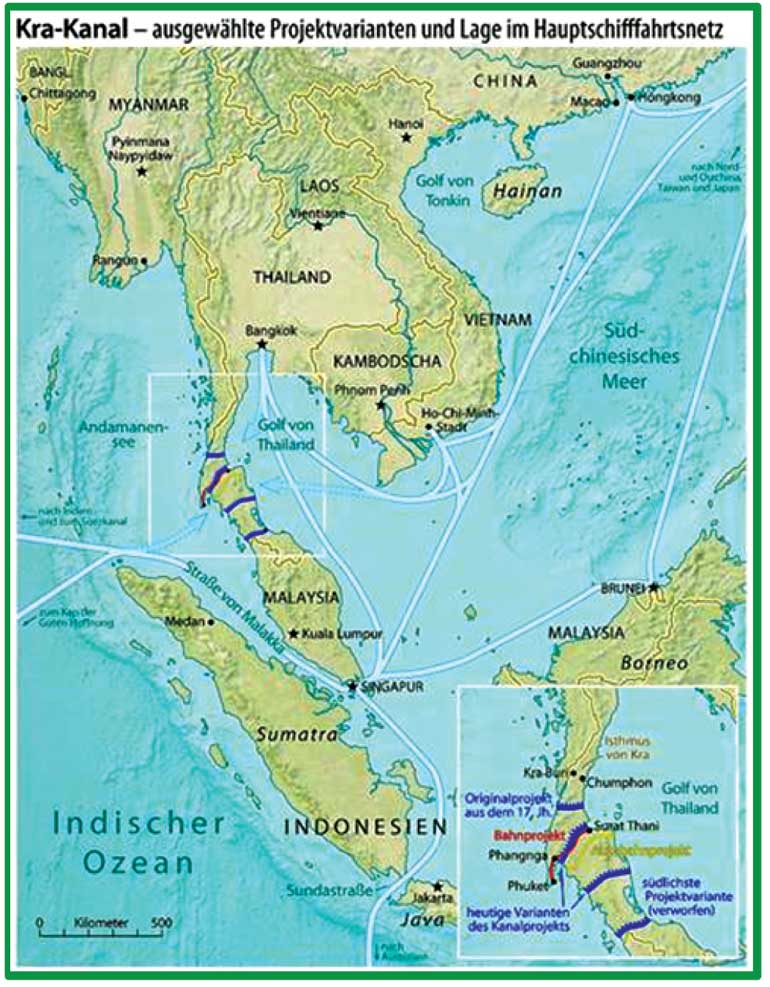Wednesday Jan 08, 2025
Wednesday Jan 08, 2025
Monday, 20 February 2017 00:37 - - {{hitsCtrl.values.hits}}
Hambantota is not a strategic port for shipping business, said Rohan J. Abeywickrema, delivering a paper at a seminar organised by the Organization of Professional Associations (OPA) at its auditorium recently.
is not a strategic port for shipping business, said Rohan J. Abeywickrema, delivering a paper at a seminar organised by the Organization of Professional Associations (OPA) at its auditorium recently.
Speaking on the subject ‘How strategic is the Port of Hambantota to the economy of Sri Lanka?’ Abeywickrema recalled the National Maritime Policy document of 2003 where reference is made to the Port of Hambantota and quoted the following recommendations contained therein:
“The strategy for developing the port is as follows: The comprehensive feasibility study that has been undertaken is to be expedited. Until such time as feasibility studies are completed, plans are finalised and funding arranged, operations such as bunkering ship supplies and other ancillary services to be started out of the Port of Hambantota.” The policy document further states: “The (old) Port of Colombo is the only port which is handling containerised cargo and for security and strategic reasons Sri Lanka should have a second port able to handle containers in an emergency [with the Colombo South port completed after this document was approved by the Cabinet of Ministers, this need no longer exists]. Development of such facilities is cost intensive and domestic cargo alone cannot generate sufficient revenue to make it economically viable.”
“Hambantota Port also requires major infrastructure such as roads, rail connection improvements in the utilities such as power, communication and water, hospitals, Schools, shopping and hotel accommodation,” he further quoted from the Policy document.
Most importantly the Policy document states: “Hambantota also has another handicap in not having a hinterland and adequate cargo volume to support a port.” Abeywickrema emphasised further that Hambantota Port does not have a hinterland to generate any cargo to make a vessel call economically viable.” Comparing the volumes of containers handled, the Port of Colombo handled 5,734,923 (TEU) in 2016, while Port of Singapore handled 36,009,000 containers (TEU) in 2016 – more than six times the volume of Port of Colombo.
“Hambantota did not handle any containers since opening in 2012,” he said. “There are also statements made that that Koggala, Biyagama and other Free Trade Zones have spare land to establish industries to generate cargo for the Port of Hambantota. FTZ zones generate only a fraction of the local containers handled even in Colombo and there is no hope to produce adequate cargo from those FTZs. “Hambantota supplied 55,100 of bunkers in 2014, and 12,064 tons in 2015 while currently Colombo handles about 350,000 tons per year. Comparatively Singapore, the world’s top bunkering port in 2016, handled 48.6 million tons compared to the 45 million tons in 2015,” said Abeywickrema.
He continued: “It was a mistake for the SLPA to embark on the sophisticated bunkering market which is not their core business. This incurred heavy losses to the SLPA. There is no need for a port in Hambantota to supply bunkering to the 200 plus vessels passing Donra Head as barges and boats can operate from Colombo, Trincomalee and Galle for this purpose and make supplies Outside Port Limit (OPL).
“RFPs have been called to develop Hambantota Port three times in the past and had failed to generate a worthwhile interest. The obvious reasons for lack of interest is the poor infrastructure, high cost of utilities, lack of a hinterland and non-availability of support services among many others.” Another misconception is about a Kra canal, a canal through the Kra Isthmus, which would have shortened shipping time between East and West. This idea was mooted as early as the year 1677 and then it resurfaced in 1793. After Burma became a colony in 1863 an exploration was undertaken. In 1897 and Thailand and the British Empire agreed not to build the Kra canal
“340 years later in 2017 the status remains the same and there is no Kra canal being built or even planned. Highest Thai authorities have confirmed this even in 2016,” Abeywickrema said. There may be a strategic importance to the Hambantota Port for military reasons and Abeywickrema said that he has not dealt with it in his presentation. He also emphasised the need to ensure that India, strategic interests and concerns are protected to their satisfaction.
“There is hope to develop Hambantota only with Maritime Industrial Development Areas (MIDAS) in and around Hambantota to generate cargo for the port e.g. importing and storing of bulk cargo such as sugar, flour, wheat, LNG, cement and re-exporting as small cargo parcels, importing crude oil refining and re-exporting, importing bulk wheat milling and exporting wheat flour, importing clinker and manufacturing cement and exporting are examples,” he said.


Abeywickrema’s belief is that through Chinese Government intervention they will shift some of the abovementioned activities currently taking place in China to Hambantota or establish new industrial activities to serve Chinese market needs.
Sri Lanka also does not have a National Policy in Port Development and there are no laid-down systems to deal with issues like tariff problems (will Hambantota undercut and offer very low rates?), curtailing inter-port competition within the country, etc. Who will be the landlord in Hambantota and who will provide navigational services? Attempts by the Chartered Institute of Logistics and Transport in Sri Lanka and the Company of Master Mariners to initiate a discussion on National Maritime Policy matters did not receive a response from the present Government. In most countries in Europe the stated port policy is for a government authority to be the landlord and terminals are owned and operated by the private sector under the control of an independent regulator. There are also safeguards in Europe for local investors and local partners in port development.
In conclusion, Abeywickrema stated that Hambantota is definitely not commercially strategic and the port can only be sustained by many port-based industries (MIDAS) and attempts to develop such industries in Hambantota have so far failed. To go forward, the Government should also develop a National Policy Framework for Ports (and other areas).